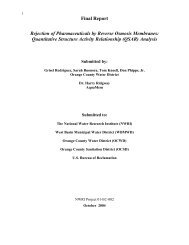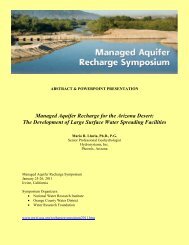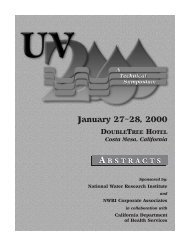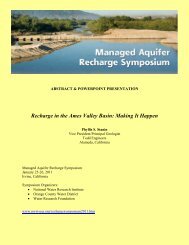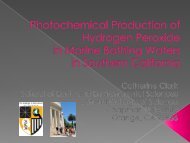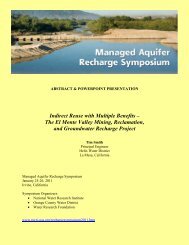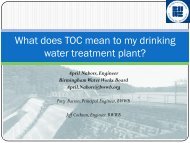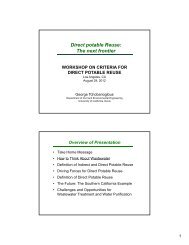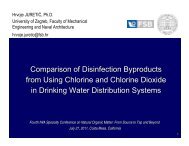RBF_Cover (for eps) - National Water Research Institute
RBF_Cover (for eps) - National Water Research Institute
RBF_Cover (for eps) - National Water Research Institute
You also want an ePaper? Increase the reach of your titles
YUMPU automatically turns print PDFs into web optimized ePapers that Google loves.
Session 8: Emerging Contaminants Removal<br />
The Fate of Bulk Organics and Emerging Contaminants<br />
During Soil-Aquifer Treatment<br />
Dr. Jörg E. Drewes<br />
Colorado School of Mines<br />
Golden, Colorado<br />
Dipl.-Ing. Tanja Rauch<br />
Colorado School of Mines<br />
Golden, Colorado<br />
Introduction<br />
Wastewater reuse employing soil-aquifer treatment is becoming an increasingly important strategy<br />
<strong>for</strong> many utilities in the United States and abroad to augment local drinking-water sources where<br />
supplies are limited. One major water-quality issue associated with soil-aquifer treatment leading<br />
to indirect potable or nonpotable reuse of wastewater effluents is the fate and transport of organic<br />
constituents. Effluent-derived bulk organic matter can impair the quality of recovered water by<br />
interfering with post-treatment processes, such as coagulation, adsorption, or membrane<br />
treatment. Bulk organic matter is also a known precursor <strong>for</strong> DBPs. The presence of bioavailable<br />
organic carbon after soil-aquifer treatment could also increase the microbial regrowth potential in<br />
distribution systems. In addition, BOM might be comprised of organic micropollutants, which<br />
survive during soil-aquifer treatment and which are associated with potential adverse human<br />
health effects. The objective of this study was to investigate the fate and transport of bulk and<br />
trace organics present in reclaimed water during soil-aquifer treatment leading to indirect potable<br />
reuse. The American <strong>Water</strong> Works Association <strong>Research</strong> Foundation and USEPA funded this study.<br />
Methodology<br />
The fate of organics during soil-aquifer treatment was investigated using controlled biodegradation<br />
studies in adapted soil-columns and full-scale infiltration facilities in Arizona and Cali<strong>for</strong>nia. The<br />
study design followed a watershed-guided approach considering hydraulically corresponding<br />
samples of drinking-water sources, soil-aquifer treatment-applied wastewater effluents, and<br />
subsequent post-soil-aquifer treatment samples representing a series of different travel times in the<br />
subsurface. Extensive characterization of organic carbon in the different samples was per<strong>for</strong>med<br />
using state-of-the-art analytical techniques (such as size-exclusion chromatography with online<br />
DOC and UV absorbance detection, carbon-13 nuclear magnetic resonance spectroscopy, Fourier<br />
trans<strong>for</strong>m infrared spectroscopy, and elemental analysis) and biomass/bioactivity measurements<br />
(dehydrogenase activity; total viable biomass through phospholipid extraction; substrate induced<br />
respiration) to distinguish between primary removal mechanisms (biodegradation versus adsorption).<br />
The mechanisms contributing to bulk organic matter removal during initial recharge were<br />
Correspondence should be addressed to:<br />
Dr. Jörg E. Drewes<br />
Assistant Professor<br />
Environmental Science & Engineering Division<br />
Colorado School of Mines • Golden, Colorado 80401-1887 USA<br />
Phone: (303) 273-3401 • Fax: (303) 273-3413 • Email: jdrewes@mines.edu<br />
159



